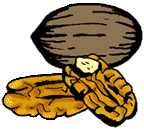  
Show Off Your Pecans! - February 3, 2010
Jeff Schalau, Associate Agent, Agriculture & Natural Resources
University of Arizona Cooperative Extension, Yavapai County
The Camp Verde Pecan, Wine and Antique Festival will be on February 12, 13, and 14. Camp Verde has a rich agricultural heritage and the Verde Valley has become a noted wine producing region within Arizona. Come to the Festival and enjoy locally grown pecans, Arizona wines from the Verde Valley and beyond, outstanding antique vendors, homemade pecan pies and baked goods, as well as lots of live entertainment. The Pecan and Wine Festival also features a pecan contest. I encourage any and all backyard pecan growers to submit their pecans for judging. Below are guidelines on how to select a pecan sample for the contest.
At a pecan show, a sample of 40 nuts taken from a single tree is judged based on: (1) size, (2) percent kernel (the percent of kernel in proportion to the whole nut), (3) kernel color, (4) in-shell appearance, (5) uniformity (size and shape), (6) number of whole kernel halves after shelling, and (7) degree of damage. The first three of all the characteristics listed above are the most important and are used by the judges in determining winners in each class in most cases. Characteristics four through seven are used when large numbers of samples are being judged.
The following suggestions should aid you in collecting and selecting the best pecans for a show once they become mature.
- Select nuts from young trees when possible. Young trees have greater vigor and produce larger, better-filled nuts.
- Select nuts from trees with lighter crops and/or fewer nuts per cluster. Heavy crops cause excessive drain on the tree resulting in poorer quality nuts.
- Harvest pecans immediately following drop. Generally, pecans that fall early are of better quality than those exposed to the elements for longer periods.
- Do not pick nuts from the shuck if the shuck is green or the nut is still attached to the shuck. This means that the pecan has not dried properly and the shell of the nut will turn a light color, which is abnormal and viewed as undesirable by judges.
- After collecting pecan samples, leave them at room temperature for two or three days so that they will dry to a suitable moisture content for shelling. After they have dried, place them in a cool, dry environment until they are submitted for judging. Make sure that nuts are open to the air and not clustered together.
- If there is more than one tree of a particular variety to select a sample from, crack and shell a few nuts from each tree and observe the interior quality. Look for solid, well-filled kernels as opposed to kernels with openings in and around the kernel. Also, observe the color of the kernel to check for insect damage (black spot). If damage is evident, select another tree or location if possible.
- Do not alter the physical in-shell appearance of the nut such as polishing or rubbing. Again, avoid nuts that show evidence of insect damage on the shell.
- If time permits, determine the weight of each individual pecan for entry so that a uniform sample will be selected. The heaviest nuts should be used for the sample. It is better to have a uniform sample than an assortment of large and small nuts. Check also for abnormal shape, cracks, splits, or blemishes.
- A qualified sample consists of 40 nuts. It is better to enter 41 or 42 nuts to be sure of your count because sometimes a nut can be lost during handling. Entries consisting of 39 or less nuts can be disqualified.
Contest entries can be taken to the Camp Verde Chamber of Commerce, 385 S. Main Street, Camp Verde on or before February 11. They are open between 9 AM and 4 PM Monday through Friday. I'll see you at the Festival!
The University of Arizona Cooperative Extension has publications and information on gardening and pest control. If you have other gardening questions, call the Master Gardener line in the Cottonwood office at 646-9113 ext. 14 or E-mail us at cottonwoodmg@yahoo.com and be sure to include your address and phone number. Find past Backyard Gardener columns or submit column ideas at the Backyard Gardener web site: http://cals.arizona.edu/yavapai/anr/hort/byg/.
Back to Backyard Gardener Home Page
|
